
Interesting Facts * Origins of the game * October 2001 Interview

Interesting Facts * Origins of the game * October 2001 Interview
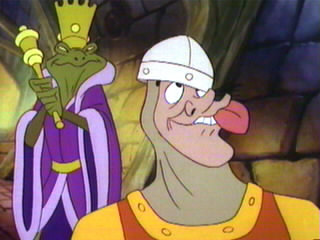 Directed
by: Don Bluth
Directed
by: Don Bluth
Written by: Alan Dean Foster (with
contributions by Don Bluth, Rob McFarlane,
John Hoffman and John Lakey)
Music by: Christopher Stone (the
same composer that wrote the music for the game in 1983)
Released on: October 2004 (originally set
for 2003
to coincide with the 20th anniversary of the game)
Running Time: 82 to 85 minutes
Budget: $
Box-Office: $ in the U.S., $ million worldwide
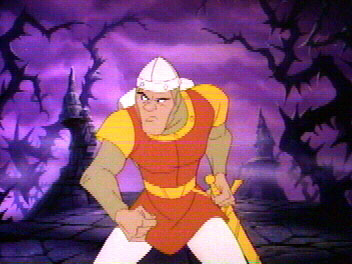 |
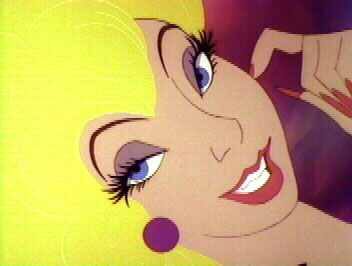 |
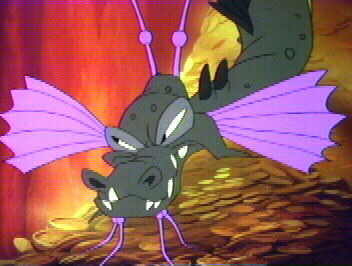 |
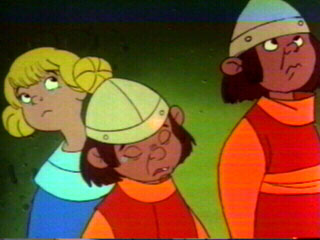 |
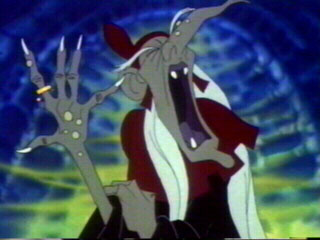 |
Dragon's Lair, The Movie is a prequel to the video games and
will follow Dirk the Daring from his birth through his early adventures.
The film will introduce a more rounded personality for damsel-in-distress
Princess Daphne, Mordroc the wizard and a new dragon. It will follow Dirk
the Daring from birth to about 16, when he becomes a knight. You will find
out why and how he becomes a knight and why he cannot talk. "We tell the
back story of Dirk the Daring and Daphne. We learn why and how Dirk becomes
a knight. We think we have a tight, entertaining story," added director
Don Bluth in March 2002.
![]() Dragon's Lair
was introduced in June 1983. The game was the first high-quality laserdisc
games in an era where many arcades still had Space Invaders and Pac Man
game cabinets. In it, you play the part of the bold knight Dirk the
Daring who has to brave the monsters of a mysterious castle in order to
save the Princess Daphne from the fire-breathing dragon, Singe. At a cost
of over a million dollars, the animation was created under complete secrecy,
finished in May 1983 -one month before the game debuted! It has generated
more than $130 million in revenue through its translation to 16 different
gaming platforms.
Dragon's Lair
was introduced in June 1983. The game was the first high-quality laserdisc
games in an era where many arcades still had Space Invaders and Pac Man
game cabinets. In it, you play the part of the bold knight Dirk the
Daring who has to brave the monsters of a mysterious castle in order to
save the Princess Daphne from the fire-breathing dragon, Singe. At a cost
of over a million dollars, the animation was created under complete secrecy,
finished in May 1983 -one month before the game debuted! It has generated
more than $130 million in revenue through its translation to 16 different
gaming platforms.
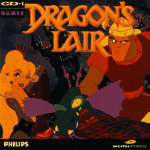 |
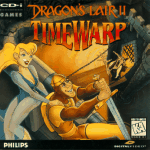 |
![]() In 1984 a cartoon
version of Dragon's Lair, made by Ruby Spears animation was shown
by ABC in America. The stories followed the adventures of Dirk, and
introduced two extra characters -Bertram the horse, and Timothy the squire.
The series featured many of the monsters from the laserdisc game, including
of course "Cinge" (spelt differently) the dragon!
In 1984 a cartoon
version of Dragon's Lair, made by Ruby Spears animation was shown
by ABC in America. The stories followed the adventures of Dirk, and
introduced two extra characters -Bertram the horse, and Timothy the squire.
The series featured many of the monsters from the laserdisc game, including
of course "Cinge" (spelt differently) the dragon!
![]() A sequel video
game, Dragon's Lair II: TimeWarp was released in 1991, after 7 years
in limbo. Set a few years after Dragon's Lair, it features
Dirk now married with 13 children -and a mother-in-law! Daphne has
been kidnapped by the sorcerer Mordrok and taken into the planes of time
to be his bride, made monstrous by Mordrok's ring kept in the Casket of
Doom.
A sequel video
game, Dragon's Lair II: TimeWarp was released in 1991, after 7 years
in limbo. Set a few years after Dragon's Lair, it features
Dirk now married with 13 children -and a mother-in-law! Daphne has
been kidnapped by the sorcerer Mordrok and taken into the planes of time
to be his bride, made monstrous by Mordrok's ring kept in the Casket of
Doom.
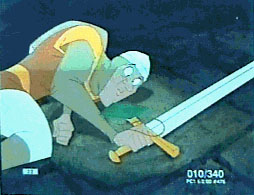 |
 |
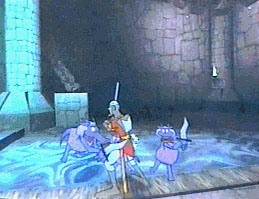 |
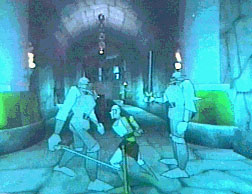 |
![]() In 2000, Don Bluth
commented: "I am surprised that Dragon's Lair has enjoyed such a
long life. But I think it is probably because Dirk is one of those
humbling characters that just can't get it right. Almost anyone
can identify with that. This very element is what gave the Little
Tramp his popularity."
In 2000, Don Bluth
commented: "I am surprised that Dragon's Lair has enjoyed such a
long life. But I think it is probably because Dirk is one of those
humbling characters that just can't get it right. Almost anyone
can identify with that. This very element is what gave the Little
Tramp his popularity."
![]() Talking about
his creation, Don Bluth added that "Dirk is a medieval knight, or at least
he thinks he is a qualitied 'knight'. He is not too bright but he has a
good heart and INCREDIBLE luck. His design is all Don Bluth, with big feet,
big hands (which helps sell the clumsy look), the exaggerated jaw also
pushes the character in this direction. Remember we didn't have Dirk talk
[in the video games], so we had to sell his personality by the way he looks
and moves. The screams and grunts helped as well. You may even see simialarities
in the character Kay from The
Sword in the Stone, who wasn't very bright either. Obviously, this
approach to designing a big clumsy oaf, we used the same thought process
in finding characteristics and caricature to communicate this type of personality."
Talking about
his creation, Don Bluth added that "Dirk is a medieval knight, or at least
he thinks he is a qualitied 'knight'. He is not too bright but he has a
good heart and INCREDIBLE luck. His design is all Don Bluth, with big feet,
big hands (which helps sell the clumsy look), the exaggerated jaw also
pushes the character in this direction. Remember we didn't have Dirk talk
[in the video games], so we had to sell his personality by the way he looks
and moves. The screams and grunts helped as well. You may even see simialarities
in the character Kay from The
Sword in the Stone, who wasn't very bright either. Obviously, this
approach to designing a big clumsy oaf, we used the same thought process
in finding characteristics and caricature to communicate this type of personality."
![]() During the official
presentation of the new game Dragon's Lair 3D (check out a demo)
at the Classic Gaming Expo in Las Vegas, NV in August 2001, Don Bluth gave
details on a feature-length Dragon's Lair animated film currently
in the works. He showed storyboards of the film and gave details on the
storyline:
During the official
presentation of the new game Dragon's Lair 3D (check out a demo)
at the Classic Gaming Expo in Las Vegas, NV in August 2001, Don Bluth gave
details on a feature-length Dragon's Lair animated film currently
in the works. He showed storyboards of the film and gave details on the
storyline:
"A thief breaks into a castle to kidnap a prince. Unfortunately, at the same time, a coup is staged by a wizard and a dragon in exchange for an elixer that promises immortality. The thief is stuck in the castle with both the real prince as well as a decoy ringer, and in his escape, he forgets which is which. He still doesn't know for the next 16 years, and one of the boys will grow up to be a knight, and one will grow up not knowing he's a king. Or maybe the knight (Dirk the Daring) turns out to be royal - we don't know, but I imagine Bluth does."
![]() Mordroc will
not be a character in the prequel. The villain in the movie is a 600 year-old
dragon by the name of Vraxxis, who becomes human in the first 10 minutes
of the film.
Mordroc will
not be a character in the prequel. The villain in the movie is a 600 year-old
dragon by the name of Vraxxis, who becomes human in the first 10 minutes
of the film.
![]() In September 2001,
Don Bluth commented on his official
Website: "We're looking forward to getting started on Dragon's Lair
the Movie. We thought it might be a little more than what was in that original
game. We have written an [original] story for Dirk and Daphne that we believe
will be entertaining for our audience. We plan to include many of the characters
that you saw in the game. We anticipate a 2003 release on the movie."
In September 2001,
Don Bluth commented on his official
Website: "We're looking forward to getting started on Dragon's Lair
the Movie. We thought it might be a little more than what was in that original
game. We have written an [original] story for Dirk and Daphne that we believe
will be entertaining for our audience. We plan to include many of the characters
that you saw in the game. We anticipate a 2003 release on the movie."
![]() On September 28,
2001, Don Bluth's team informed me that: "Dragon's Lair is still
in pre-production. The script is complete and we have been storyboarding.
We have a cast selection for the voices but the actors have not been secured.
It will be done in a style, very similar to the original game. Actually
production will begin went the financing has been placed. We prefer
to finance privately then do a distribution deal when we have product to
show the distribution companies. However, we do have interest from
two of the distribution companies that know how to distribute animation."
As of late December 2001, Don's team was still preparing storyboards and
working out the script.
On September 28,
2001, Don Bluth's team informed me that: "Dragon's Lair is still
in pre-production. The script is complete and we have been storyboarding.
We have a cast selection for the voices but the actors have not been secured.
It will be done in a style, very similar to the original game. Actually
production will begin went the financing has been placed. We prefer
to finance privately then do a distribution deal when we have product to
show the distribution companies. However, we do have interest from
two of the distribution companies that know how to distribute animation."
As of late December 2001, Don's team was still preparing storyboards and
working out the script.
![]() Don Bluth and
Gary Goldman talked to Dan Molina about reprising his role of Dirk the
Daring for the Dragon's Lair movie,
"at least for a couple of dream sequences. However, we have a very good
choice of actors to play Dirk." As of mid-October 2001, the two producers
revealed that they "are still in the meeting stages with several finance
candidates. We hope to close an agreement before the end of November. However,
with the state of the world politics there are a lot of nervous people.
Once we close on a deal, we will begin casting and recording. The storyboard
process has already begun. Don hopes to board most of the motion picture
himself, as he did on NIMH, An
American Tail and Land Before
Time. We do not plan on putting together a large studio. We will
have a core group here in Phoenix."
Don Bluth and
Gary Goldman talked to Dan Molina about reprising his role of Dirk the
Daring for the Dragon's Lair movie,
"at least for a couple of dream sequences. However, we have a very good
choice of actors to play Dirk." As of mid-October 2001, the two producers
revealed that they "are still in the meeting stages with several finance
candidates. We hope to close an agreement before the end of November. However,
with the state of the world politics there are a lot of nervous people.
Once we close on a deal, we will begin casting and recording. The storyboard
process has already begun. Don hopes to board most of the motion picture
himself, as he did on NIMH, An
American Tail and Land Before
Time. We do not plan on putting together a large studio. We will
have a core group here in Phoenix."
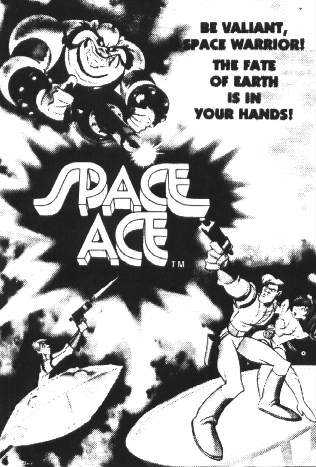
![]() In October 2001, Don Bluth's team revealed that they were already working
on their other laserdisc animated game, Space Ace. "We are working
on the script [right now] as our second feature." Two months later, Don
Bluth confirmed that he was still "working on a concept." In February 2002,
the director explained: "after doing Titan A.E.,
our appetites were whetted for science fiction, and Space Ace takes
a very humorous approach to sci-fi." Released in 1983,
Space Ace
features the hero, Ace, being hit by Borf's Infanto Ray, which turns Ace
into Dexter, a spindly teenager! The process can be temporarily reversed,
however, if Dexter takes one of his supply of Proton Pills. Space Ace
played as an interactive animated film rather than a game, and was publicized
and marketed as a film by the Bluth group, with cinema-style posters and
press kits. It failed to do as well as Dragon's Lair because it turned
out to be an expensive untried product being introduced into a struggling
market: featuring technological improvements (stereo sound for one), Space
Ace required arcade owners to obtain a completely new game cabinet
rather than just swap the ROM and laserdisc.
In October 2001, Don Bluth's team revealed that they were already working
on their other laserdisc animated game, Space Ace. "We are working
on the script [right now] as our second feature." Two months later, Don
Bluth confirmed that he was still "working on a concept." In February 2002,
the director explained: "after doing Titan A.E.,
our appetites were whetted for science fiction, and Space Ace takes
a very humorous approach to sci-fi." Released in 1983,
Space Ace
features the hero, Ace, being hit by Borf's Infanto Ray, which turns Ace
into Dexter, a spindly teenager! The process can be temporarily reversed,
however, if Dexter takes one of his supply of Proton Pills. Space Ace
played as an interactive animated film rather than a game, and was publicized
and marketed as a film by the Bluth group, with cinema-style posters and
press kits. It failed to do as well as Dragon's Lair because it turned
out to be an expensive untried product being introduced into a struggling
market: featuring technological improvements (stereo sound for one), Space
Ace required arcade owners to obtain a completely new game cabinet
rather than just swap the ROM and laserdisc.
![]() "In January 2001,
Don Bluth's rep explained that "we have used live action models for many
of the human characters in our films. However, the character animation
in the video games did not have live action reference for their movements.
We were on a very limited budget and all care was taken to economize the
production. Don designed Daphne from poses of Playboy magazine's playmates
of the month. Gary had stored his collection of the magazines in the studio's
attic. Daphne's face was sort of a Don Bluth caricature of Marilyn Monroe.
Don Posed the scenes for the animators, John Pomeroy animated the majority
of the Daphne scenes especially the close-ups. Vera Lanpher, one of our
top clean-up artists was the voice of Daphne. Vera now works at Walt Disney
Feature Animation."
"In January 2001,
Don Bluth's rep explained that "we have used live action models for many
of the human characters in our films. However, the character animation
in the video games did not have live action reference for their movements.
We were on a very limited budget and all care was taken to economize the
production. Don designed Daphne from poses of Playboy magazine's playmates
of the month. Gary had stored his collection of the magazines in the studio's
attic. Daphne's face was sort of a Don Bluth caricature of Marilyn Monroe.
Don Posed the scenes for the animators, John Pomeroy animated the majority
of the Daphne scenes especially the close-ups. Vera Lanpher, one of our
top clean-up artists was the voice of Daphne. Vera now works at Walt Disney
Feature Animation."
![]() "We think we can
get this movie done for $30 million with a staff of 160 people," Don Bluth
commented in February 2002. "We have a staff of seven that has been working
on the story. The way I work with co-director Gary Goldman, I do the preproduction
with the storyboarding and layouts and then turn the reins over to Gary.
We're currently researching whether to make the film full 3-D CGI or traditional
2-D with some CGI." The film, which was then seeking a distributor, is
expected to begin production by May 2002. The 18- to 22-month schedule
that has been mapped out for a traditional 2-D animated film could be expanded
should Bluth and company decide to go with a CGI feature. "Should we decide
to go full CGI, we'd use similar technology to that which was developed
for the new game, which uses Toon Shader to create 3-D models that will
have a unique 2-D cel animated look," said Goldman. "We'd have our 2-D
animators assist the 3-D animators with the facial expressions and traditional
animation techniques." The hope is to launch Dragon's
Lair as a feature film franchise and reinvigorate the game franchise
with additional adventures.
"We think we can
get this movie done for $30 million with a staff of 160 people," Don Bluth
commented in February 2002. "We have a staff of seven that has been working
on the story. The way I work with co-director Gary Goldman, I do the preproduction
with the storyboarding and layouts and then turn the reins over to Gary.
We're currently researching whether to make the film full 3-D CGI or traditional
2-D with some CGI." The film, which was then seeking a distributor, is
expected to begin production by May 2002. The 18- to 22-month schedule
that has been mapped out for a traditional 2-D animated film could be expanded
should Bluth and company decide to go with a CGI feature. "Should we decide
to go full CGI, we'd use similar technology to that which was developed
for the new game, which uses Toon Shader to create 3-D models that will
have a unique 2-D cel animated look," said Goldman. "We'd have our 2-D
animators assist the 3-D animators with the facial expressions and traditional
animation techniques." The hope is to launch Dragon's
Lair as a feature film franchise and reinvigorate the game franchise
with additional adventures.
![]() In late February
2002, Don Bluth confirmed that the movie is not movie forward as fast as
originally hoped: "Dragon's Lair is still in the presentation stage.
We are very excited about our script and the designs that Don has created.
Dirk is way different until he gets his full knight costume (he gathers
bits and pieces as the movie progresses). We don't want to give too much
away right now, as things change. We are still planning the characters
as 2D. We have a list of actors that we plan on approaching, based on the
personalities of the characters. The biggest hurdle is funding the project."
In late February
2002, Don Bluth confirmed that the movie is not movie forward as fast as
originally hoped: "Dragon's Lair is still in the presentation stage.
We are very excited about our script and the designs that Don has created.
Dirk is way different until he gets his full knight costume (he gathers
bits and pieces as the movie progresses). We don't want to give too much
away right now, as things change. We are still planning the characters
as 2D. We have a list of actors that we plan on approaching, based on the
personalities of the characters. The biggest hurdle is funding the project."
![]() The production
is considering inserting "Dirk Death outtakes" at the end of the film.
The production
is considering inserting "Dirk Death outtakes" at the end of the film.
![]() As of March 2002,
the movie was still not in production. "However, the script is done and
we are very happy with the story. It is a prequel to the story in the original
game. It is the story of how Dirk becomes a knight. Princess Daphne is
also introduced in the movie. A lot of Dragon's Lair lovers are anxiously
waiting for this movie and the 3D game that is due out in August or September
of this year. The movie, if started in the next 60 days, could be ready
for release by Christmas of 2003. Titan A.E.
was done, from start to finish, in 19 months. Dragon's Lair is nowhere
near the complexity of that film." Don Bluth went on to add that the movie
would take about 22 months to produce. But in May 2002, the feature
was still not in pre-production: "we [now] believe it will be 2004 before
it will be distributed."
As of March 2002,
the movie was still not in production. "However, the script is done and
we are very happy with the story. It is a prequel to the story in the original
game. It is the story of how Dirk becomes a knight. Princess Daphne is
also introduced in the movie. A lot of Dragon's Lair lovers are anxiously
waiting for this movie and the 3D game that is due out in August or September
of this year. The movie, if started in the next 60 days, could be ready
for release by Christmas of 2003. Titan A.E.
was done, from start to finish, in 19 months. Dragon's Lair is nowhere
near the complexity of that film." Don Bluth went on to add that the movie
would take about 22 months to produce. But in May 2002, the feature
was still not in pre-production: "we [now] believe it will be 2004 before
it will be distributed."
![]() The style of this
movie will be reminiscent of the original game, but have more of a "feature
film" quality. The script is described as a dark action-comedy.
The style of this
movie will be reminiscent of the original game, but have more of a "feature
film" quality. The script is described as a dark action-comedy.
![]() In April 2002,
directors Don Bluth and Gary Goldman said that the projects they had the
most fun doing were probably "the video games, Dragon's
Lair and
Space Ace. We didn't really know or understand
what the editorial process was going to be, or really, how the game play
would turn out. So, we just had fun with it. The comradery was fantastic.
A lot of experimentation and freedom took place with the animation. Some
of the crew even got to voice the characters. Dan Molina, the editor, was
the voice of Dirk. Vera Lanpher, the head of Key Clean-up, was the voice
of Princess Yum Yum (Daphne). On Space Ace, animator Lorna Pomeroy
(Cook) was the voice of Kimberly, animator Jeff Etter was the voice of
Ace and animator/storyman Will Finn was the voice of Dexter. Don [Bluth],
himself, was the evil Borf."
In April 2002,
directors Don Bluth and Gary Goldman said that the projects they had the
most fun doing were probably "the video games, Dragon's
Lair and
Space Ace. We didn't really know or understand
what the editorial process was going to be, or really, how the game play
would turn out. So, we just had fun with it. The comradery was fantastic.
A lot of experimentation and freedom took place with the animation. Some
of the crew even got to voice the characters. Dan Molina, the editor, was
the voice of Dirk. Vera Lanpher, the head of Key Clean-up, was the voice
of Princess Yum Yum (Daphne). On Space Ace, animator Lorna Pomeroy
(Cook) was the voice of Kimberly, animator Jeff Etter was the voice of
Ace and animator/storyman Will Finn was the voice of Dexter. Don [Bluth],
himself, was the evil Borf."
![]() In June 2002,
Don Bluth announced that the script was complete. "We exposed the opening
and some storysketch continuity in the Don Bluth's ToonTalk
magazine. We do not have distribution at this time. Most of our films did
not have distribution until we were about 10 months to a year into production,
i.e. The Secret of NIMH(1982)
and All Dogs Go to Heaven(1989).
We want this to be a theatrical release. We are in discussions with the
major studios for distribution. We've had some 'passes' but, some are still
in the running. Even if we are passed-over by everyone, it ain't really
over...remember that Star Wars (1976) was turned down by everyone
in Hollywood and even near completion, 20th Century Fox was still in doubt.
We are very passionate about getting Dragon's Lair to the big screen.
The challenge is, that the studios do not really know the game industry,
other than it makes more money than the film industry--well, maybe they
don't know that information. The world-wide fan base for the Dragon's
Lair title is huge and we believe we have a built-in audience."
In June 2002,
Don Bluth announced that the script was complete. "We exposed the opening
and some storysketch continuity in the Don Bluth's ToonTalk
magazine. We do not have distribution at this time. Most of our films did
not have distribution until we were about 10 months to a year into production,
i.e. The Secret of NIMH(1982)
and All Dogs Go to Heaven(1989).
We want this to be a theatrical release. We are in discussions with the
major studios for distribution. We've had some 'passes' but, some are still
in the running. Even if we are passed-over by everyone, it ain't really
over...remember that Star Wars (1976) was turned down by everyone
in Hollywood and even near completion, 20th Century Fox was still in doubt.
We are very passionate about getting Dragon's Lair to the big screen.
The challenge is, that the studios do not really know the game industry,
other than it makes more money than the film industry--well, maybe they
don't know that information. The world-wide fan base for the Dragon's
Lair title is huge and we believe we have a built-in audience."
![]() "Some [animators
from the original game] have been in contact with us about the project,"
explains Gary Goldman. "Some are at Disney and some at Dreamworks. They
expressed working on the project on a freelance basis. We'll see how many
actually return for an encore. We've talked to John Pomeroy, Dan Kuenster,
Dave Spafford. Everyone is waiting for the go ahead. There will be some
CGI in the film, both characters and props plus some CGI backgrounds. We
will want access to CGI tools to do some special shots, like moving around
and through the backgrounds. We'll do our best. We really want to get this
film moving forward. We are very happy with the script."
"Some [animators
from the original game] have been in contact with us about the project,"
explains Gary Goldman. "Some are at Disney and some at Dreamworks. They
expressed working on the project on a freelance basis. We'll see how many
actually return for an encore. We've talked to John Pomeroy, Dan Kuenster,
Dave Spafford. Everyone is waiting for the go ahead. There will be some
CGI in the film, both characters and props plus some CGI backgrounds. We
will want access to CGI tools to do some special shots, like moving around
and through the backgrounds. We'll do our best. We really want to get this
film moving forward. We are very happy with the script."
![]() Gary Goldman admitted
in July 2002 that "Lilo & Stitch's
success is definitely a plus for 2D" and would help speed up the funding
of Dragon's Lair: The Movie.
Gary Goldman admitted
in July 2002 that "Lilo & Stitch's
success is definitely a plus for 2D" and would help speed up the funding
of Dragon's Lair: The Movie.
![]() However, a month
later, the directors admitted that they were not sure that Dragon's
Lair would be their next project after all. "We are still in discussions
with major studios for distribution. We have a couple of feature film scripts
ready to go. We will announce which picture will be first." In December
2002, Don Bluth revealed that "Dragon's Lair the Movie is currently
planned for an October, 2004 completion. We still have not completed a
distribution deal."
However, a month
later, the directors admitted that they were not sure that Dragon's
Lair would be their next project after all. "We are still in discussions
with major studios for distribution. We have a couple of feature film scripts
ready to go. We will announce which picture will be first." In December
2002, Don Bluth revealed that "Dragon's Lair the Movie is currently
planned for an October, 2004 completion. We still have not completed a
distribution deal."
![]() Gary Goldman revealed
in November 2002 that the "first treatment was submitted by Dragon's
Lair fan and prolific novelist, Alan Dean Foster. The new script is
a comedy, set in the dark atmosphere of a medieval world. It is a prequel
and we think very entertaining."
Gary Goldman revealed
in November 2002 that the "first treatment was submitted by Dragon's
Lair fan and prolific novelist, Alan Dean Foster. The new script is
a comedy, set in the dark atmosphere of a medieval world. It is a prequel
and we think very entertaining."
![]() Don Bluth is also
in development of Fenwick, A Christmas story, "plus we are discussing
film rights on two very popular books. We have other properties that are
in various stages of development but Dragon's Lair and Fenwick
are definitely next in line." A script for Fenwick had been completed
by February 2003. By then, Don Bluth's team had also "written several half-hour
scripts based on classic short stories that we would like to do as Direct-to-Videos.
Financing is the issue now."
Don Bluth is also
in development of Fenwick, A Christmas story, "plus we are discussing
film rights on two very popular books. We have other properties that are
in various stages of development but Dragon's Lair and Fenwick
are definitely next in line." A script for Fenwick had been completed
by February 2003. By then, Don Bluth's team had also "written several half-hour
scripts based on classic short stories that we would like to do as Direct-to-Videos.
Financing is the issue now."
![]() Comic book mini-series
based on Dragon's Lair and Space Ace were released in August
2003. "We never explored it as much as we could have," Don Bluth commented
at the time. "The books will add a bit more depth to the story than the
games did so that you get involved with the characters." Bluth's partner,
producer/director Gary Goldman, adds that "we tried to do almost a sequel
that maintains the characters from the original games but stays away from
the storylines of the upcoming films." According to Bluth, they were still
pursuing funding for a Dragon's Lair feature and scripts have been
written for both properties. The pics are part of full slate of feature
projects in the works at The Bluth Group. The company will be employing
both 3D and 2D animation with five of the movies set to be traditionally
animated with some CG elements. Bluth is astounded at how well the properties
have held up. "The reason for keeping these legends alive is that the games
remain popular in stores. They should have been off the shelf 18 years
ago, but whatever is happening, it's there and we want to take full advantage
of it," he says.
Comic book mini-series
based on Dragon's Lair and Space Ace were released in August
2003. "We never explored it as much as we could have," Don Bluth commented
at the time. "The books will add a bit more depth to the story than the
games did so that you get involved with the characters." Bluth's partner,
producer/director Gary Goldman, adds that "we tried to do almost a sequel
that maintains the characters from the original games but stays away from
the storylines of the upcoming films." According to Bluth, they were still
pursuing funding for a Dragon's Lair feature and scripts have been
written for both properties. The pics are part of full slate of feature
projects in the works at The Bluth Group. The company will be employing
both 3D and 2D animation with five of the movies set to be traditionally
animated with some CG elements. Bluth is astounded at how well the properties
have held up. "The reason for keeping these legends alive is that the games
remain popular in stores. They should have been off the shelf 18 years
ago, but whatever is happening, it's there and we want to take full advantage
of it," he says.
![]() Don Bluth said
on September 25, 2003 that "we have a current budget for a traditional
animated approach with CG backgrounds and props at just under $30 Million.
The script and presentation is with a couple of distributors at this time.
Keep your fingers crossed."
Don Bluth said
on September 25, 2003 that "we have a current budget for a traditional
animated approach with CG backgrounds and props at just under $30 Million.
The script and presentation is with a couple of distributors at this time.
Keep your fingers crossed."
DON BLUTH TALKS ABOUT THE CREATION OF DRAGON LAIR
"Before the completion of The Secret of NIMH we began production on a second feature, East of the Sun West of the Moon. MGM/UA released Nimh around the 4th of July in1982. In August of that year the cartoonists union voted to strike. Though our animation team did not agree, they were asked to leave the studio by the union representative.
There we sat, Don, John and Gary, our production manager and the receptionist, wondering what we would do to get something going. In October Rick Dyer with his company, Advanced Micro Computers, approached us. He had an idea to create an interactive video game using laser disc technology. He also had a story of a hapless medieval hero, Dirk the Daring, whose quest was to save the kidnapped princess Daphne from an evil, fire-breathing Dragon. It was a great concept. It excited us. The story needed work and characters needed to be redesigned, but the idea and technology sounded great.
For the next 4 months we struggled to stay afloat. We had no incoming monies and due to the strike, our production of East of the Sun, West of the Moon, was shut down. From November to mid-January we borrowed money from family and friends. Finally, Don's brother found a lawyer that represented some investment money (just in time). We worked like crazy to put together a demo of the "attract mode" and 3 working episodes of Dirk in action. It was shown at the March 1983 game show, in Chicago. The game was a hit and our distributor, Cinematronics wrote orders on the spot. Money started to flow and we were suddenly in full production.
We delivered the final game for the arcades in early summer and jumped
into a second game "Space Ace". 1983 turned out to be a very busy year.
Since then, Dragon's Lair has remained extremely popular and active.
We [have finished] working with Rick Dyer in the creation of a new 3D Dragon's
Lair game. We're really looking forward to having full control of Dirk's
actions!"
October 2001 interview from SciFi.
Q: What prompted your decision to turn Dragon's Lair into
a movie, and what challenges have you faced in the process?
Gary Goldman: We've been asked for about 16 or 17 years
now when we will make Dragon's Lair into a movie, because it's been so
popular, especially among the younger animators. Every year—for every picture
we do—we get a lot of job applications. There's a big turnover in animation.
People are like gypsies who move from one camp to the next. But we're getting
a whole new batch of younger animators, and every wave of younger animators
asks the same question: "Won't you, please, do Dragon's Lair? I'd love
to work on Dragon's Lair. All the animators will come running to you if
you start this project—and they'll probably be willing to work for nothing,
because they'd love the project so much." Not that we'd take advantage
of that, but I think it brings home the idea that the characters are very
popular. When Don first designed Dirk for the game, he pushed the
idea that Dirk was like Everyman. He wasn't real bright; he was sort of
a C student. He meant to do the right thing, he meant to do right, but
he wasn't that great. We called him our Charlie Chaplin. I think the message
got across. The characters were endearing to everyone. The fact that Dirk
could rescue the princess—or you as an interactive player could rescue
the princess—put Dirk in the position of every guy playing the game. It
related. And I think what we're doing with the film will relate, as well,
to the young people today who are being introduced to the game in all the
different formats. It's been in about 15 different formats—including DVD
and DVD-ROM and CD-ROM—and right now we're working on a 3-D version of
the game that will be out next March.
Q: Seems like you've got a lot of Dragon's Lair projects going on.
Gary Goldman: Yes. It's interesting, because even 18
years ago, when we did Dragon's Lair, we promoted it like a movie, and
licensees came out of the walls wanting to do product—action figures and
dart games that were Dragon's Lair games and little squirt guns. Sixteen
or 17 different major companies came out of the woodwork based on Dragon's
Lair, because it was such a hit in 1983.
Q: How do you translate an interactive game into a movie where you
have a single possible plot line?
Gary Goldman: We're going to try to introduce many things
that people saw in the game, but the story is going to be the key ingredient.
The title will be really attractive to the audience, but the key is whether
our story captures their imagination. Don's been working very hard during
the last six weeks to reintroduce things to that film that they remember
from the game.
Q: Which particular features of the game do you want to retain for
the film—and which ones do you want to drop?
Don Bluth: One of the attractive parts of the game was
what we called the Death Node—where you can watch all the strange ways
that Dirk is defeated. I have to keep the action a little like that in
places, so you can enjoy those moments again. There is a bit of nostalgia
about all this, so we've got to do that. Another thing that was really
glaring to me: Dirk didn't talk in the games. In a full-length movie, we
need him to talk somewhere. I'm trying to address that. The other part
is Daphne was an airhead. Back then, in the arcade, you could get away
with the boys going in there and saving a princess who wasn't real bright,
but you can't in a movie. I believe you have to set a role model. Every
time you do an animated film, it's going to go to the kids—the girls and
boys—and they're going to pattern things after it. So Daphne has to take
off her mask and be revealed as someone who has substance. That's a big
challenge right there, because you don't want the boys to go, "Oh no, she's
smart." But I think we have to go there. So we've made Daphne and Dirk
kind of competitive. It's almost like the Moonlighting thing. They're very
competitive, but when push comes to shove, they're rescuing each other,
which is the way it should work. Those are big issues. Visually, we brought
in the old Giddy Goons and their king—stuff like that. So you'll see a
bit of nostalgia. But there's got to be something new and fresh. What I
picture happening when we finally get into production is that some of the
old crew that built the original games will probably reassemble to build
this film. That's going to be fun too—all getting together one more time.
Q: There will be one new element in the mix that wasn't there in
the arcade game: actors.
Gary Goldman: [Woefully] I know.
Q: Have you decided who you want for the characters, or are you in
negotiation?
Gary Goldman: We've got a cast list, but we don't want
to reveal the names before we've spoken with their agents. But I think
you'd be real pleased with the people we've chosen. They're from very popular
sitcoms and very fine actors. Some people who've never even done film before.
Don Bluth: But people who do comedy. It's going to be
a comedy.
Q: Speaking of actors brings up the subject of direction. Just how
do you direct a cartoon?
Don Bluth: If you look at the big overview of making
an animated film, it is really very similar to making a live-action film.
You're dealing with theater. A play has to have a beginning, a middle and
an end. It has to have a climax and all those plot points in it—the same
things. So the key—besides a good story—is actors who can pull it off.
Unfortunately, what we run into with animators—and they don't like to hear
this—is that they're trained very, very carefully in graphics. They can
do graphics very well, and a lot of them can draw extremely well. But that
business of acting is so elusive, and actors spend their whole lives learning
how to do that craft. It's very difficult, being brave enough to take off
everything and let yourself go out there and take risks. Actors go to school
for it. They spend their whole lives doing it, and maybe 30 or 40 years
after they've started, they say, "I think I'm finally starting to understand
what acting is." But making an animated film, essentially, you require
acting from people (animators) who aren't trained as actors. So all we
can do is get the actors to come over to our house for a while and shoot
some of this stuff. We film them. They actually try to lip-sync to prerecorded
dialogues and everything. They begin to act like they are the people in
the script, and they share their expertise on how their characters should
be acting. Once you've got that, you can go back to the animators and say,
"Look at this, study it, understand and analyze it. Understand what these
actors are trying to accomplish, because that's your job too."
Q: So the actors contribute to their characters almost from the start.
Gary Goldman: Mainly the voice actor, because not only
do you bleed over creating the script and getting the dialogue to work
for you, but the actor has to catch on and give you a performance. Directing
an animated movie is directing performance in every category through 28
departments, plus the recording and scripting of the film. It's really
more about performance. That actor who's giving you the voice performance
is bringing all the things that Don talked about from the actor's career
in acting and all his experience of life to bring life to those lines of
dialogue. We record the tracks first, create a radio show, then animate
to that.
Don Bluth: There is one more thing in here. All along
the way, every time one of the actors or the animators or the color stylists
or anyone touches this picture, the desire is that the picture springs
upward in quality. That everyone is creative enough that they're not just
following a rote system. The voice actors come in and give it everything
they've got within the framework of what they understand the action to
be. But when we shoot the live action, it won't be with the same actors
who do the voice. It will be different actors, because they don't cost
as much. The visual actors give, at least, vision to what could be. Hopefully,
the animators can see a vision that goes even further and that won't hem
them in. You know, go your own way. If you can do better, do better. And
understand that you are an actor first and a graphics artist second.
Gary Goldman: The other thing is something Don and I
were talking about the other day: the difference between a film actor and
a stage actor. Animation is more like stage acting. We exaggerate. We caricature
the character's movements. Whereas in film, it's all scaled down, all the
dramatics. You may not even move. Sometimes, you may not even blink. In
stage acting, the makeup is flamboyant. You've got to project to those
people in the nosebleed seats. It's a different kind of performance. Our
duty is to bring the character to life—the brain, the heart, the breathing.
We try to move the character in a three-dimensional space.
Don Bluth: We work with a flat piece of paper. It's flat.
You have to give the impression that you actually go into the paper, that
it's dimensional. You have to draw a two-dimensional design that shows
three dimensions. That becomes very difficult for the novice artist until
they understand that you have to think around the character, although you're
drawing flat.
Q: That leads into CGI and all the new techniques that are out there
now. I know you worked with some CGI on Titan
A.E....
Gary Goldman: And on Anastasia
as well and Bartok the Magnificent. We worked with CGI all the way
back to All Dogs Go to Heaven,
which was back in '88, '89. We think it's a wonderful new tool. It all
depends on how people use that tool.
Q: Did you see Final Fantasy?
Gary Goldman: It was disappointing. They did so much
reality, which was gorgeous. But the voice actors' performance was much
higher than the animators' performance with the characters. The acting
on the vellum was so flat and unanimated. Visually unanimated. They spent
all their time worrying about the pores on the skin and getting it to look
as real as possible that they weren't getting—Like when a sculptor creates
a sculpture, he creates an armature first. If you come by our booth [in
the Exhibitors Hall at Dragoncon 2000] and watch Don draw the characters
for the fans who come by, he'll do a really rough sketch just to get the
pose right before he starts to draw. You got to see it, then do it. I think
the CGI animators on Final Fantasy—or it could be the fault of the
director—were focusing on the wrong syllable.
Don Bluth: Another thing, with CGI right now, the misconception
is that the more real we can get things to be, the better off we are. But
if you keep going towards real, towards real, why not just photograph it?
You miss something along the way. I think what you're missing is that the
aim of art is not to be realistic? The aim of art is to caricature what
you feel about life around you and do it in such a way that people say,
"Oh, I recognize that. I recognize that!" But it's a fresh, new view of
it.
Q: If you, with CGI computer, could come up with a human that's as
real as a human that you photograph what, really, have you done?
Gary Goldman: Did you watch Shrek?
People say that the articulation of the characters wasn't really good CGI.
Sure it was. It was so different and fresh and new, and the story and the
script performance were really well done. The idea of that little miniature
donkey—everybody was going to get discarded, and they all end up around
Shrek. Eddie Murphy's character, the donkey, was actually a dog. All his
movements were done like a dog. I got a big kick out of it. That performance
and that perspective hit a chord with everybody. Everybody really enjoyed
it. It wasn't about trying to achieve some sort of reality—which they did.
But among CGI people, some people were pointing fingers and saying, they
can do better than that. (Maybe it's sour grapes, the way people point
fingers at each other.) But I thought they did a terrific job on that film.
Q: Final Fantasy and Shrek represent two trends in
animation. What about the third—what about anime?
Don Bluth: Anime is becoming really, really popular,
and it's strange, because we have two animation camps here. One of them
is the Disney camp, which represents children. Then you have anime, which
represents young adults and, maybe, on up. I think anime is becoming popular
because it's OK to watch it. You won't be threatened with your age. Anime
has some stuff that's really, really good, that's fun to look at; and it
has some stuff that's not so much fun visually. But the thing about anime
for me is that they get into story, and some of the stories are kind of
fun. They're good—some of them. Some of them aren't. But it's also "monkey
see, monkey do." People will go where everyone else is going. It's the
sheep syndrome. They will all go there. They don't know why they like it,
but all their friends and everybody in their age group like it. So it must
be good. So they'll go there. I think the discernment comes later. They'll
start to pick out the things that are really, really good and like them.
The things that aren't so good, they'll leave. And they don't leave the
Disney backyard forever. Usually they come back when they get their own
kids, or when they hit about 20, 21. Then it's OK again to watch it, because
they feel secure about their adulthood. But anime is a good thing. And
I think Cartoon Network is a good thing, because it's helping people recognize
comic as an art form.
Gary Goldman: The thing that's interesting to me is that
I lived in Japan when I was in the Air Force, back in the early '60s, and
anime wasn't there yet. I think Speed Racer might have been in its infancy.
But I remember the comic books. Comic books were as prolific in Japan as
they were in Belgium, where there are more cartoonists per capita than
anywhere else in the world. I was telling Don just the other day that anime
is a reflection of those comic books they had in Japan in the '60s. When
I was in Japan promoting Anastasia
and Titan A. E., I was informed that
anime is the cheapest form of filmmaking in Japan. So it's prolific, because
of the cost of producing the product and the return. It's very, very expensive
to do live action in that country, so animation is just everywhere. It's
part of the culture now, and it's due to economics. Economics drive everything—from
your magazine to our films.
|
||||||||||||